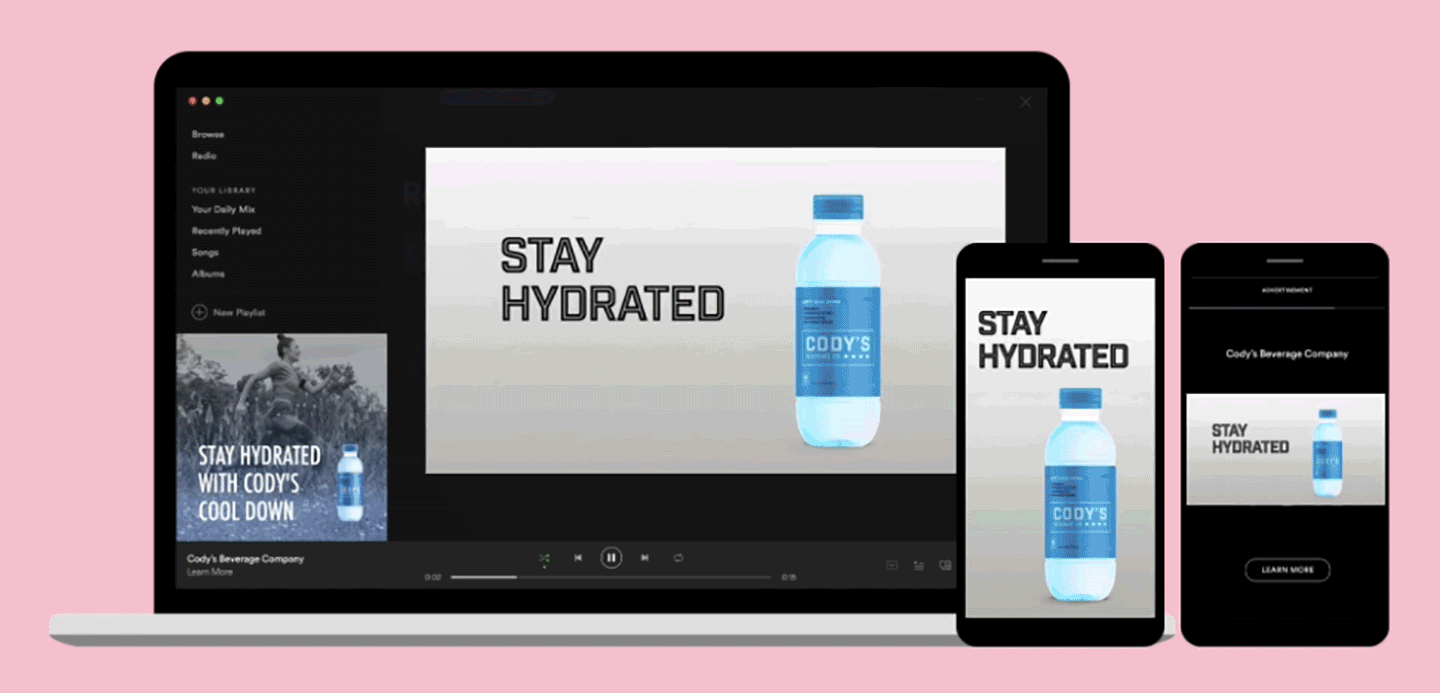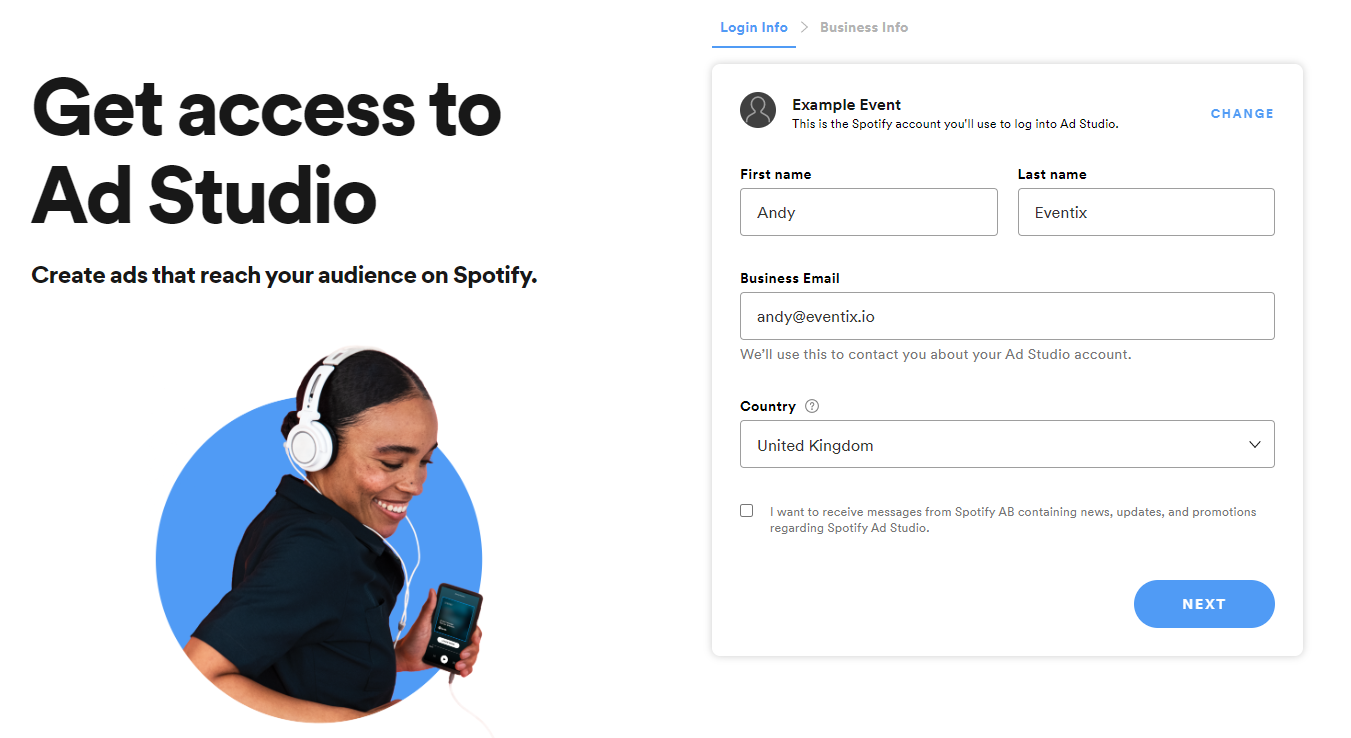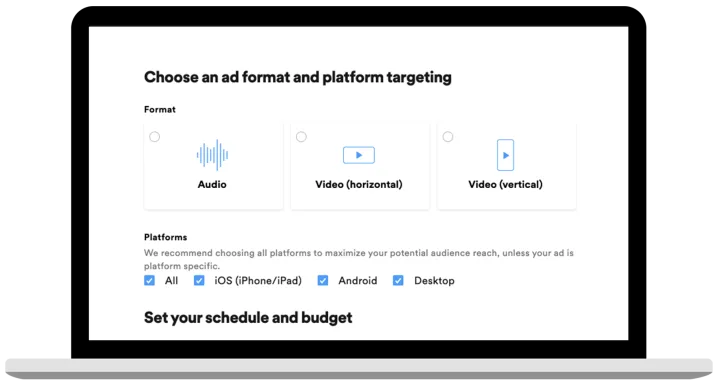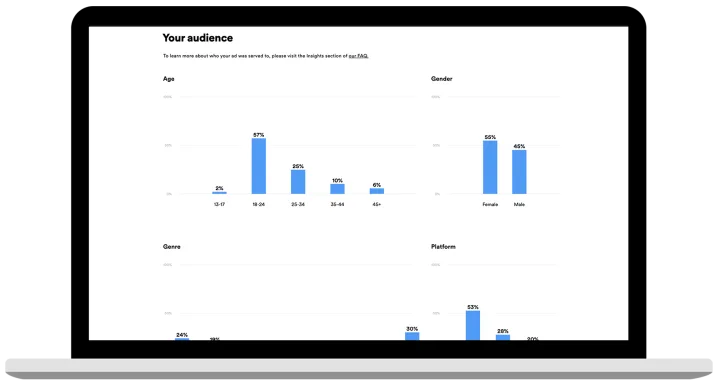Ticket shop
Easily embedded into your website
2 July, 2020 - 7 min. read
Spotify recently announced the launch of video advertising in it’s existing ad studio, opening up all sorts of opportunities for targeting listeners. Spotify, which is generally known as an audio-only platform, claims it is particularly suited for video advertising. Whereas viewers on other platforms, such as YouTube, tend to watch ads while muted, Spotify listeners are more likely engaging with their sound on. So how can this benefit event organisers? How can you use this to boost attendance at your event(s)?
Last week's launch of video ads for Spotify opens up a lot of avenues for event organisers who want to accurately and effectively target a particular artist’s listeners. The video ads expand the existing Ad Studio, which is, in essence, a self-service platform. Anybody can make an account and set up an ad campaign. We’ll show you how to do this below, but first, we want to walk you through what these ads look like and how best to utilise them as an event organiser.
In the past, Spotify ads came in the form of the traditional audio ads, display ads, overlays, homepage takeovers, branded playlists, video takeovers (which take place externally) and sponsored sessions. If you would like to read more about the other methods of advertising on Spotify, this is a good source. As you can see, there are already plenty of ways of advertising on Spotify, but what we’re interested in is what video ads have to offer for event organisers.
Much like audio ads, video ads on Spotify are only visible to free users and can be up to 30 seconds in length. Ads pop up after the user has listened to about 15 minutes of music. The video can have either a horizontal or vertical aspect ratio, however, the latter will limit your exposure to mobile users only.
The video can also be accompanied by a so-called ‘companion image’, which will show up where the artist’s artwork would usually be. For desktop users, that’s the bottom-left corner of the application, whereas mobile users will only see this on their device’s lock screen. The companion image can be used to show your logo or to add some information to your image, for instance.

Of course, with all the other options available for promoting your event, you might wonder why you would ever use video ads for Spotify. Well, one reason is due to the fact that, unlike other platforms such as YouTube, Spotify users don’t mute the audio during a video ad. The lack of muting ensures that, even if the users aren’t actively watching the video, they are still getting the message. In fact, Spotify goes out of its way to ensure that video ads are only shown during in-focus moments where users are actively browsing the software.
Depending on how users engage with the app, these moments could be quite limited, which is why Spotify suggests the combination of both audio and video ads. By adding more variety to your ads you can paint a more nuanced picture of your event and appeal to more potential visitors. This is incredibly easy to do as both types of ads can be managed through Spotify’s Ad Studio.
So, once you’ve decided you want to start advertising through Spotify, these are the steps you’ll need to follow to get your first video ad up and running.
Go to Spotify Ad Studio and create an account, otherwise, login if you already have an account. You’ll need your company’s VAT number in order to finalise your account, so make sure you have it handy or you’ll be put on a waiting list!

You’ll need to tell Spotify what your ad campaign is promoting. Your choice here will have an effect on the targeting and reporting options that you’ll be able to see, relating to your campaign. The options available are either ‘an artist on Spotify’, ‘a concert or artist merch’, or alternatively ‘a brand, product or organisation’. Assuming you’re an event organiser, I imagine you’ll want to pick the second option.
You’ll also need to choose the format you would like to use for your ad and select what platforms it will be available on. Keep in mind that picking a vertical video format will limit the platforms your ad will be shown on to iOS and Android. You will also need to set your schedule and budget here.

The options for targeting are quite vast. As of now, you can select your audience by their age, gender, location, and platform. Furthermore, you can pick a more specific category to filter by. The options here are either genre, interests or real-time contexts.
When you select ‘Genre’ your ad will target people who were just listening to the selected genre, whereas ‘Interests’ will target people based on their streaming of podcasts or playlists. ‘Real-time contexts’ will target people listening at specific moments in playlists.
There is a fourth option here which is only available if you choose a music-related campaign: the ‘Fan base’. By selecting Fan base you can target fans of a particular artist that is featured at your event or fans of similar artists who may also be interested. As an event organiser, this is very likely the category you will be targeting (either this or ‘genre’).
EVENTIX TIP: An artist’s profile on Spotify
An often overlooked fact is that event organisers can create their own artist profile on Spotify. By doing so, you gain access to loads more ways of promoting your event. In this blog, we show you what options are available to you and how you can use them.
You can easily upload your audio or video ad, but you can also use the inbuilt voiceover tool to create your own audio ad on the spot. This can be incredibly handy if you want to make an ad campaign on a budget and don’t have time to pre-produce an ad. You can read more about this nifty feature on their website.
Let’s not forget that we’re here for the video ads though! So how does that work? Well, there isn’t a nifty tool for creating a video ad in the Ad Studio, but there are some guidelines that your video should follow. You can find them in this file.
Once you’ve uploaded your video and set your ad live, you should start to see the statistics fill up in the reporting section of Ad Studio. This process usually takes a full day, so allow for some time. You’ll be able to browse through all sorts of common metrics. Check out this link, if you would like to know more about each of the stats and how they can help you.

Hopefully, you were able to pick up a thing or two about video advertising through Spotify.